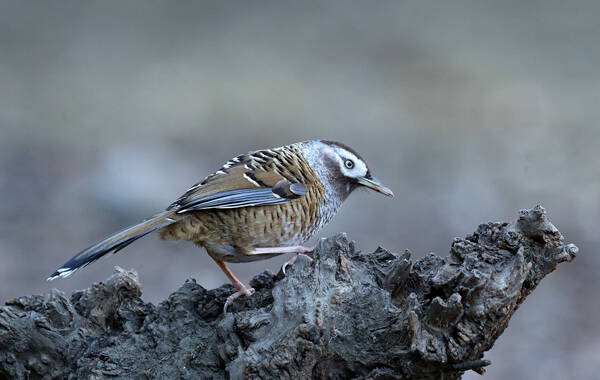Garrulax lunulatus
IUCN
LCBasic Information
Scientific classification
- name:Garrulax lunulatus
- Scientific Name:Garrulax lunulatus,Barred Laughingthrush,Ianthocincla lunulata
- Outline:Songbird
- Family:Passeriformes Ophiura
Vital signs
- length:24-28cm
- Weight:72-95g
- lifetime:No verification information
Feature
The lines before, around and behind the eyes are all white, forming a wide white eye circle, like an eye mask.
Distribution and Habitat
The Spot-backed Laughingthrush is a bird endemic to China, and is only distributed in southern Gansu, southern Shaanxi, northeastern, northern, western, central and southwestern Sichuan.
The Spot-backed Laughingthrush mainly inhabits high mountain coniferous forests, mixed coniferous and broad-leaved forests, subtropical evergreen broad-leaved and bamboo forests at an altitude of 1,400-2,600 meters, and also moves in and out of sparse forest shrubs at the edge of forests, secondary forests and ground edge shrubs.
Appearance
Male and female plumage is similar. The forehead, top of the head and back of the neck are chestnut brown, the white in front of the eyes is connected to the wide white eye circle and extends to the back of the eyes in the shape of an eyebrow, and the rest of the head is light chestnut brown. The back, shoulders, waist and upper tail coverts are generally light brown, and each feather has a brown tip and a wide black subterminal horizontal spot. These black subterminal spots and brown terminal spots become narrower on the waist and tail coverts, and the brown terminal spots even become less obvious, making the black spots appear more numerous and more prominent. The inner wing coverts and tertiary flight feathers are similar to the back in color and pattern. The winglets are blue-gray, the primary coverts are black, and both have white terminal spots; the flight feathers are black-brown, and the feather tips are also white. The outer edges of the primary flight feathers are blue-gray,
Details
Barred Laughingthrush, also known as Barred Laughingthrush in English, is a medium-sized bird of the family Noctuidae and the genus Laughingthrush, with two subspecies.

There is still controversy about the subspecies differentiation of Barred Laughingthrush. Deignan (1964), Zheng Zuoxin (1976), Zheng Zuoxin et al. (1987), Li Guiyuan et al. (1985), Tang Chanzhu (1996), etc. also classified the species of Garrulax bieti described by Oustalet (1897) based on the specimen collected from Weixi in northwestern Yunnan into this species, thus dividing it into three subspecies. However, most scholars outside China believe that the White-spotted Laughingthrush should be regarded as an independent species (Vaurie, 1959; Waiters, 1980; De Schanensee, 1984; Howard and Moore 1980, 1991; Inskipp et al., 1996). The reason is that they are obviously different in morphology (Berlioz, 1930) and their calls are also different (Robson.pers.comm, 1996). Vaurie (1965) believed that their distribution areas may overlap in Sichuan. Zheng Zuoxin (1994) also followed the opinions of most scholars recently and regarded the White-spotted Laughingthrush (Garrulax bieti) as an independent species, and divided the species into two subspecies, namely the nominate subspecies and the Liangshan subspecies. The main difference between the two subspecies is that the forehead, top of the head to the back of the neck of the nominate subspecies are chestnut brown, and the sides of the head, chin, throat and upper chest are light chestnut brown; the forehead to the back of the Liangshan subspecies are dark brown, and the sides of the head, chin, throat and upper chest are light dark brown.
The White-spotted Laughingthrush (Garrulax bieti) is very similar to the Spot-back Laughingthrush, and it is difficult to distinguish them in the wild, but the White-spotted Laughingthrush is slightly larger and has a white end spot on its back instead of a brown end spot.
Spot-backed Laughingthrush often moves in pairs or alone, rarely in groups, and mostly moves in the bushes under the forest and on the ground. When active, it frequently calls, and the call is loud and monotonous, and its sound is similar to "Guer, Guer".
Spot-backed Laughingthrush mainly feeds on insects and plant fruits and seeds. During the breeding period, it mainly feeds on insects such as beetles and caterpillars, and during the non-breeding period, it mainly feeds on plant food. According to the 16 bird stomachs analyzed by Li Guiyuan et al. (1985), except for the 3 stomachs in April and May that were all insects, there were 4 stomachs with both animal and plant food, and the remaining 9 stomachs were all plant food, mainly fruits and seeds of plants such as Rosaceae, Leguminosae, Cyperaceae, Rubiaceae, Caprifoliaceae, Viburnum, Elaeagnus, ivy, and Rubus.
The Spot-backed Laughingthrush is a bird endemic to China, with a narrow distribution area, a small population, and is uncommon. It is a rare and endangered bird.
Listed in the "Red List of Threatened Species of the World Conservation Union" (IUCN 2016 ver 3.1) - Least Concern (LC).
Listed in the "National List of Terrestrial Wildlife with Important Economic and Scientific Research Value" issued by the State Forestry Administration of China on August 1, 2000.
It has been listed in the "Global Endangered Bird List" by Bird Life International.
Listed in the "National Key Protected Wildlife List" (Level 2) issued by the State Forestry and Grassland Administration and the Ministry of Agriculture and Rural Affairs of China on February 5, 2021.
Protect wildlife and eliminate game.
Maintaining ecological balance is everyone's responsibility!








